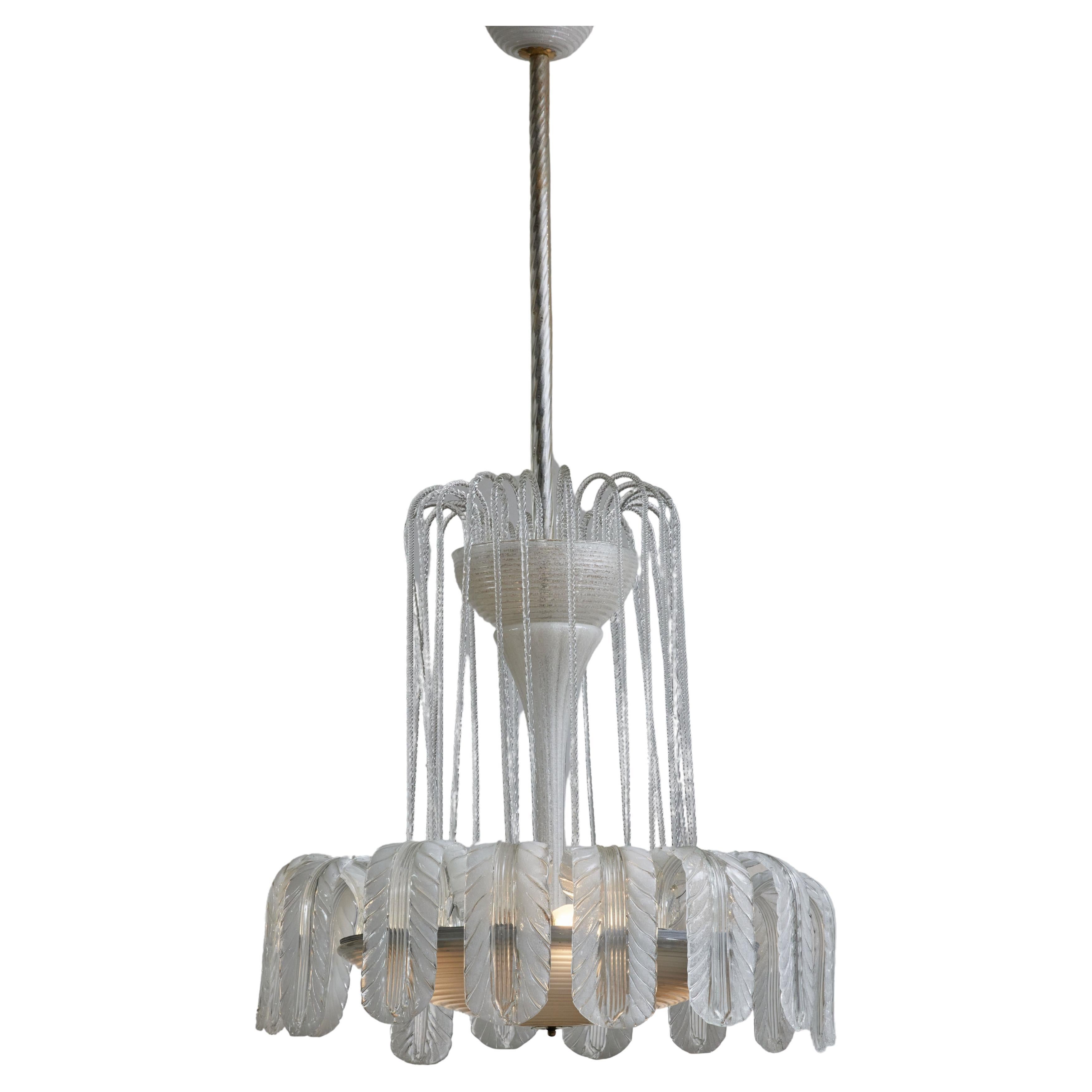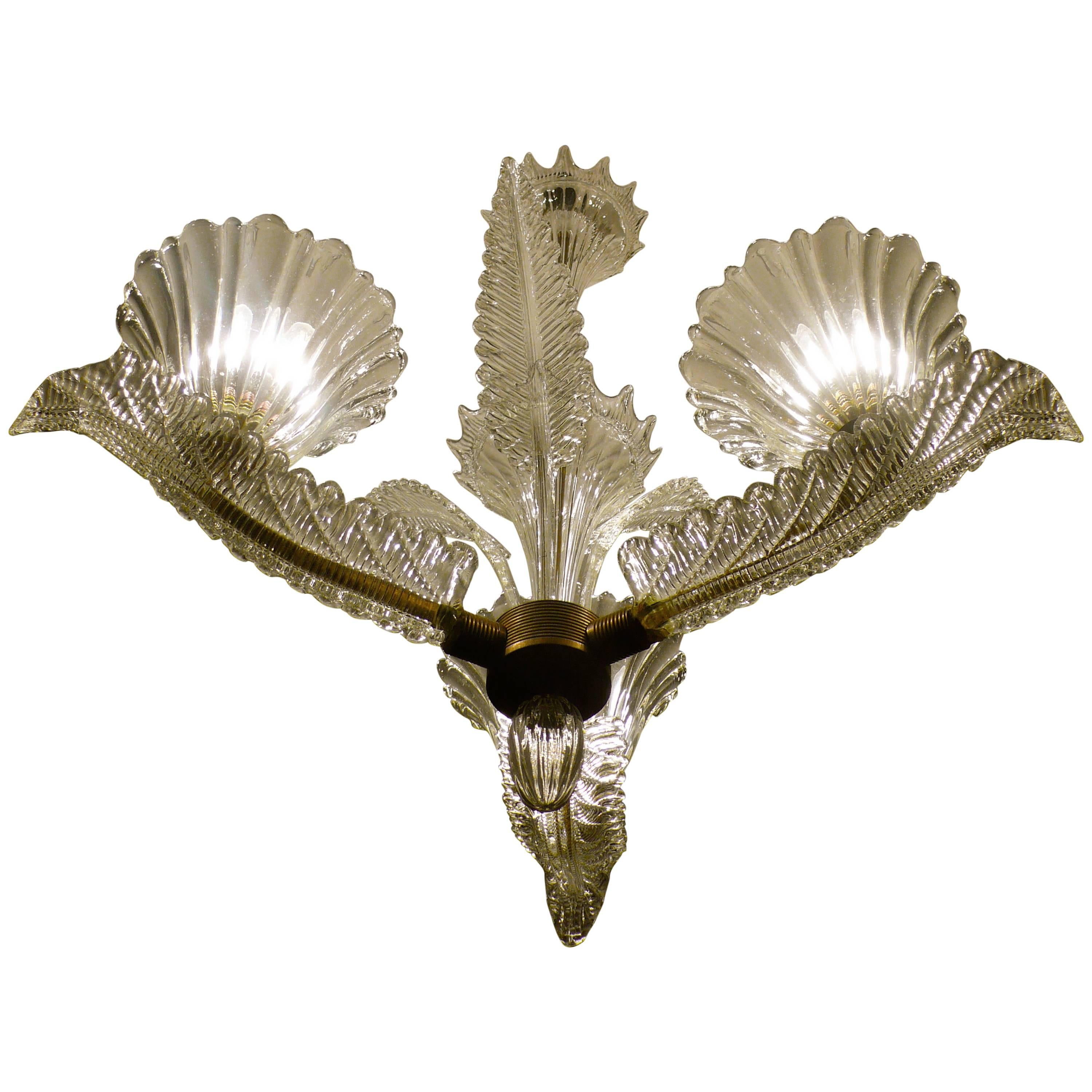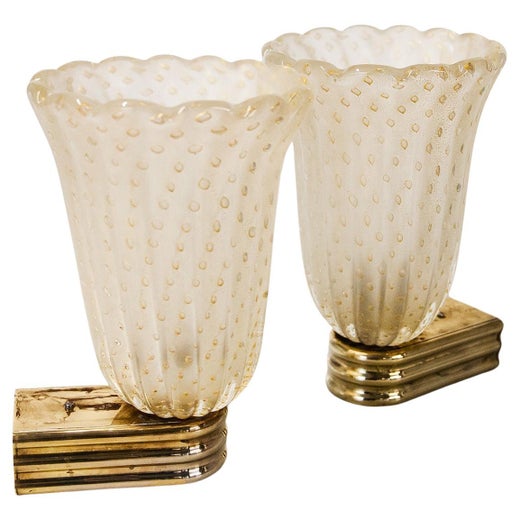Murano Glass Chandelier By Barovier
About the Item
- Creator:Ercole Barovier (Designer),Barovier (Maker)
- Dimensions:Height: 36.5 in (92.71 cm)Diameter: 31.5 in (80.01 cm)
- Power Source:Hardwired
- Voltage:12v
- Lampshade:Included
- Style:Art Deco (Of the Period)
- Materials and Techniques:
- Place of Origin:
- Period:
- Date of Manufacture:1940
- Condition:Wear consistent with age and use. Good age appropriate condition. No chips or cracks to glass. Newly wired for the U.S. market.
- Seller Location:Houston, TX
- Reference Number:
Ercole Barovier
Ercole Barovier left an indelible mark on the world of Italian modernist glassmaking — his vibrant use of color and exploration of innovative techniques yielded glass vases, chandeliers and other lighting and decorative objects that stand out in any interior many decades later.
Barovier grew up on the Venetian island of Murano, a region of the world famed for its production of artisanal glassworks. By the time he was born, in 1889, his family had already been in the glassmaking business for centuries, as the Barovier dynasty began in 1295. Nonetheless, Barovier did not choose glassmaking as his first career — he instead studied medicine as a young man before going on to work as a radio operator in the first World War.
The year after the war ended, Barovier joined his family’s business (over time, the manufactory’s names have included Fratelli Barovier, Vetreria Artistica Barovier & C. and Artisti Barovier). He was appointed artistic director in 1926, and subsequently managed the business with his brother Nicolò. From 1927 onward, Barovier was the chief designer at his family’s glassworks. He became sole proprietor in 1934, and in 1936, merged his own family business with the Venetian glass factory SAIAR Ferro Toso. They renamed the company Barovier & Toso, a name under which the company still operates today.
Early in his career, Barovier garnered praise for his work with murrine glass, one of the traditional arts for which Murano is widely known. In the 1930s, he began pushing the boundaries of tradition and experimenting with new ways to bring color into his glass objects.
Ercole Barovier is credited with having invented colorazione a caldo senza fusione, a method of introducing metals and oxides into glassworks. His style became defined by his use of riotous color and later, audacious forms. He created sculptures, table lamps and other pieces using mosaic techniques to add a kaleidoscope of striking hues to his work. Barovier had a particular gift to bring out glass’s unique properties to refract and filter light in every shade of the rainbow.
Barovier took endless inspiration from the world around him, from the play of light reflecting off the canals near his home to artworks from classical antiquity. Prior to World War II, his works included naturalistic designs including floral sconces, vine-wrapped chandeliers and sea life-inspired bowls (the manufactory was known for sinuous lighting pieces that are often described as embodying “Liberty Style” — the Italian term for Art Nouveau).
Barovier focused on reinterpreting classical techniques and styles in the postwar years. Geometrically patterned vases that recalled Ancient Greek pottery in their bold forms — as well as precisely detailed Art Deco glass serving bowls — are among his characteristic works from this period. Gold leaf was applied as a decorative flourish, and Barovier worked to ensure that his pieces reflected contemporary trends. His mid-century glass is particularly sought after by today’s collectors.
Up until his retirement in 1972, Barovier continued his exploration of the creative potential in glassmaking. His fearlessness in combining cutting-edge techniques with deeply traditional practices led him to create over 25,000 designs over the course of his life.
Barovier’s work garnered international acclaim. He received many awards and accolades, including awards at the Milan Triennial exhibitions in 1933 and 1954, the Paris Universal Exhibition in 1937, and the Compasso d'Oro in 1956.
On 1stDibs, find vintage Ercole Barovier lighting, decorative objects and serveware.
Barovier
The Barovier dynasty began in 1295, when Jacobello Barovier, mentioned in historical documents as a master glassblower, began pinching, cutting, blowing and twisting a molten mixture of sand and minerals into incandescent works of art. It remained entirely family-owned until the mid-20th century, when it merged with another glassworks to become Barovier&Toso.
Partnerships come and go within the community of glass-making artisans on the Venetian island of Murano, where business relationships seem as complex as the shifting alliances in the notoriously acrimonious Italian parliament. Formed in 1942 by members of families with centuries of experience in the craft, Barovier&Toso has proven to be one of the most enduring and prosperous Italian glass manufactories of recent decades. Under the nearly 50-year artistic directorship of cofounder Ercole Barovier (1889–1974), the company created buoyant traditional pieces such as chandeliers, sconces and other lighting fixtures, and it pioneered an array of innovative modernist glass designs with bold colors, patterns and surfaces.
To appeal to gentler, more conservative tastes, Barovier&Toso produced a range of lilting, sinuous lighting pieces that are often described as embodying “Liberty Style” — the Italian term for Art Nouveau, taken from the name of famed London department store Liberty & Co., which promoted 19th-century organic textile designs and Arts and Crafts-style furniture in the manner of William Morris. The hallmarks of the style in Barovier&Toso works are elements of glass in the shape of thick leaves, fronds and flower petals, deployed along with other naturalistic ornament in sconces, pendants and chandeliers.
Ercole Barovier began his personal aesthetic transition toward modernism in the 1930s with his Primavera series of vases and animal sculptures — idiosyncratic milky-white and clear glass filled with tiny bubbles and hairline interior fissures that he produced for Artisti Barovier, a firm headed by his father and uncle (the company also traded under Fratelli Barovier and Vetreria Artistica Barovier & C. throughout its history). Later, with Barovier&Toso, Ercole would explore such novel styles as the mosaic-like Pezzato glass; fluid Spiral patterns; the pebbly textured Barbarico line and the complex, layered and highly colored abstractions of the Oriente series of vases and bowls.
Traditional or modern, Barovier&Toso — still under family control — has produced one of the finest and most diverse catalogues of Murano glass in the last 100 years.
Shop antique Barovier chandeliers, sconces and other lighting and decorative objects on 1stDibs.
- ShippingRetrieving quote...Ships From: Houston, TX
- Return PolicyThis item cannot be returned.
- Murano Glass Lantern Attributed to Ercole BarovierBy Ercole Barovier, Barovier, Barovier&TosoLocated in Houston, TXMurano Glass lantern attributed to Ercole Barovier. This stunning Barovier attributed Murano lantern, circa 1940, is made of clear glass with gold inclusions and has been newly wire...Category
Vintage 1940s Italian Hollywood Regency Lanterns
MaterialsMurano Glass
- Vintage Murano Glass Floor Lamp by BarovierBy Seguso, Ercole Barovier, Salviati, Venini, BarovierLocated in Houston, TXVintage murano glass floor lamp by Barovier. This stunning tall murano glass lamp is comprised of both clear and lightly gold infused g...Category
Vintage 1960s Italian Hollywood Regency Floor Lamps
MaterialsBlown Glass, Murano Glass
- Murano Glass Two Tiered Chandelier by SegusoBy Barovier, Salviati, Venini, Seguso, Archimede SegusoLocated in Houston, TXMurano glass two tiered chandelier by Seguso. This stunning Murano glass chandelier is executed in a very light gold color. There ar...Category
Vintage 1940s Italian Hollywood Regency Chandeliers and Pendants
MaterialsBlown Glass, Murano Glass
- Murano Glass Chandelier, Mangiarotti InspiredBy Barovier, Mazzega, Venini, Vetri, Angelo MangiarottiLocated in Houston, TXMurano glass chandelier, Mangiarotti inspired. Interesting large Murano chandelier or Murano glass lantern inspired by Mangiarotti of Murano, Italy. This stunning Mid-Century Modern Murano glass chandelier has blown glass chain pendants creating a lovely effect. Our offered Hollywood Regency Murano glass...Category
Vintage 1960s Italian Mid-Century Modern Chandeliers and Pendants
MaterialsChrome
- Murano Glass Lamp Attributed to BarovierBy Ercole Barovier, Barovier&Toso, Venini, Paolo Venini, BarovierLocated in Houston, TXMurano glass lamp attributed to Barovier. Vintage Italian Murano glass lamp on lucite or acrylic base attributed to Barovier. This V...Category
Vintage 1940s Italian Hollywood Regency Table Lamps
MaterialsBlown Glass, Murano Glass, Acrylic
- Vintage Murano Glass Chandelier by Carlo Nason for MazzegaBy Barovier, Carlo Nason, MazzegaLocated in Houston, TXVintage Murano glass chandelier by Carlo Nason For Mazzega. This stunning Mid-Century Modern four tier Murano chandelier is per...Category
Vintage 1960s Italian Mid-Century Modern Chandeliers and Pendants
MaterialsChrome
- Murano Glass Chandelier by BarovierBy BarovierLocated in West Palm Beach, FLThis stylish Murano glass and antiqued brass chandelier dates to the 1990s and was created by Barovier. Note: Requires three candelabra based light bulbs. Note: Dimensions of t...Category
Late 20th Century Italian Hollywood Regency Chandeliers and Pendants
MaterialsBrass
- Murano Glass Chandelier by BarovierBy BarovierLocated in Dallas, TXMid Century Modern blue-gray Murano Glass chandelier, by Barovier, Italy 1990s. The large chandelier has six lights/arms and white fabric new shades. The neoclassical style ceiling light is made of a blue-gray Murano glass and chrome mounts. The Italian chandelier has been professionally rewired for the US, using Candelabra base or E12 sockets. The large Murano light...Category
1990s Italian Mid-Century Modern Chandeliers and Pendants
MaterialsChrome
- Fountain Style Murano Glass Chandelier by BarovierBy BarovierLocated in Saint-Ouen, IDFStunning vintage chandelier from the 1930s in Murano glass and brass settings, by Barovier. Several handmade delicate parts compose this amazing piece, ribbed hand opened clear etched glass canopy and bowls, fluted vertical tube to decorate the stem, torciglione glass bursting out of the upper bowl to imitate the water flowing out of the fountain and sixteen leaves, also imitating the water movement. Barovier & Toso The name Barovier & Toso refers to one of the oldest Italian houses specialized in Murano glass objects. The house was founded in 1295 and still producing Murano glass objects to this day. The surname may not sound Italian. And for good reason, it comes from Berry, like those men-at-arms thanked by land for having well defended the lord of Castelfranco Veneto, a locality near Venice. The Baroviers embarked on the exploitation of glass and settled in the 14th century on the island of Murano, where the doges confined the ovens to protect the neighbor city of Venice, whose dwellings were at the time built of wood. During the Renaissance, Angelo Barovier assumed important responsibilities within the community of Murano and built a good part of the development of the local glass activity, in addition to the introduction of so-called "crystalline" glass and the “murrine” technique developed by his daughter, Marietta. At the end of the 19th century, the house became known as “Fratelli Barovier”, during this new era, the two brothers, Benvenuto and Giuseppe Barovier introduced the fabrication of the “murrini fusi” glass. The house became “Barovier & Toso” when in 1942 it merged with the Toso family of glass...Category
Vintage 1930s Italian Art Deco Chandeliers and Pendants
MaterialsBrass
- Murano Glass Chandelier by Ercole BarovierBy Ercole BarovierLocated in Tarrytown, NYVintage handblown clear glass [rostrato] oblong-shaped chandelier comprised of six lights. Ornate silver fittings and steel structure. Measures: Stem is 31 in H and it can be shor...Category
Mid-20th Century Italian Chandeliers and Pendants
MaterialsArt Glass
- Barovier Murano Glass Bell ChandelierBy BarovierLocated in Austin, TXA superb two-tone lantern of stamped Murano glass. The glass alternates between a clear and smoke tone. The beautiful bell shape of the fixtures hangs from a brass rod concealed insi...Category
2010s Italian Modern Chandeliers and Pendants
MaterialsBrass
- Charming Murano Glass Chandelier by Ercole Barovier, 1940sBy Ercole BarovierLocated in Rome, ITWonderful Liberty chandelier made around the year 1940 to the Murano glass factory by Ercole Barovier. Three large cups supported by three leaves.Category
Vintage 1940s Italian Art Deco Chandeliers and Pendants






